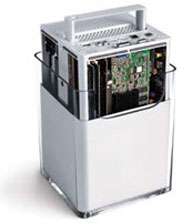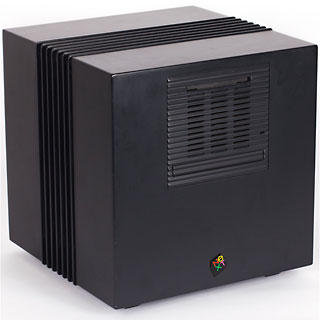2000: There’s no nice way to say it: Apple stock tanked on Friday. AAPL opened at $53.50 on Friday, dropped immediately below the $30 mark, and closed the day at $25.75.
Blame It On the Cube
Apple’s news release, Apple to report lower than expected fourth quarter earnings, blamed an anticipated reduction in earnings on three factors:
- Lower September sales in all parts of the world.
- Lower than expected education sales.
- A “slower than expected start” for the G4 Cube.
 Reduced September sales are not unique to Apple. Other computer companies and businesses such as Kodak reported weak September sales.
Reduced September sales are not unique to Apple. Other computer companies and businesses such as Kodak reported weak September sales.
Lower than expected education sales has two probable causes: the delayed introduction of the 350 MHz entry-level iMac until September and the growing dominance of Wintel computers in education.
Then there’s the Cube. It’s not the sales success Apple expected.
Surprise?
Is anyone really surprised, besides perhaps Steve Jobs? From its introduction at Macworld Expo in July, everyone in the industry sums up the Cube the same two ways: incredibly cool and overpriced.
 Incredibly Cool
Incredibly Cool
The Cube is gorgeous. It’s nearly as sexy as the Ruby iMac, which a lot of us consider the best color yet for an Apple computer.
The Cube is powerful. It has a 450 MHz G4 processor. Until the Cube came out, you had to pay US$2,500 for that level of power. And, for $500 more, you can have Apple build you a 500 MHz Cube.
The Cube comes with a 20 GB hard drive, unless you want to order a bigger one. It has a top-loading DVD drive, which is a bit like a toaster for CDs, CD-ROMs, and DVDs.
It’s compact (8″ square and 10″ tall), lucite, quiet, and hides all the cables beneath the computer.
 Overpriced
Overpriced
It’s also $200 more than the full-size 400 MHz Power Mac G4, which has more drive bays, room for an internal Zip drive, a DVD-RAM option, and three empty expansion slots. It’s also nearly as fast as the 450 MHz Cube.
The Power Mac G4 looks like a workhorse. It is one.
The Cube offers slightly better processor performance, far fewer expansion options, and is saddled with a positively pedestrian 5400 RPM hard drive. (A favorite upgrade among Cube owners is replacing that drive with a bigger, faster 7200 RPM drive.)
Is It the Cube’s Fault?
The only way the Cube makes sense from a cost and performance standpoint is its slightly faster processor. Balance that with the relatively slow hard drive, limited expansion options, and higher price, and it shouldn’t surprise anyone that it’s not flying off the shelves like iMacs or iBooks.
There’s a simple problem with the Cube, a very simple problem that everyone seems to be ignoring.
The Cube is elegant, but you lose that elegance when you connect an external floppy, Zip drive, CD burner, or tape drive. You’ve got your drop dead gorgeous Cube, a pair of spherical speakers, the Pro Mouse and Pro Keyboard, maybe even an Apple display, and this third-party box that looks completely out of place next to the Cube.
The only way the Cube works is without external drives. You lose the whole effect once you add a USB or FireWire device next to the Cube.
Or Is It Steve Jobs’ Fault?
 I think we can place the blame squarely at Steve Jobs’ feet. His Macintosh project yielded a compact computer with severely limited expansion options. When he founded NeXT, his first computer was a drop dead gorgeous black cube with no floppy drive.
I think we can place the blame squarely at Steve Jobs’ feet. His Macintosh project yielded a compact computer with severely limited expansion options. When he founded NeXT, his first computer was a drop dead gorgeous black cube with no floppy drive.
Steve’s minimalism gave us a floppy-free iMac, followed by Power Macs, PowerBooks, and iBooks that dispensed with floppy drives. Surely the Cube has no need of a floppy!
True. However, one of the cardinal rules of computing, right after “Save early, save often,” is “Back up your work.” Since long before the iMac came out, Mac users have been using Zip drives as a popular option for backing up, archiving, and transporting files.
External drives don’t look out of place with the iMac, Power Mac, or even PowerBooks and iBooks. However, they don’t match the Cube.
In his quest for minimalism, Steve Jobs left no room for an internal Zip drive or CD burner in the Cube. It probably would have increased the footprint to at least 9″ square. It might even have provided room for a single short PCI expansion slot. But it would have ruined the Cube’s elegantly understated aesthetic.
Unless Apple can address this issue, perhaps by working with some outside vendors on peripherals to match the Cube, it’s very elegance works against it.
Maybe we’ll see some creative solutions: a CD-RW drive that sits beneath the Cube, a Zip drive finished in silver and transparent plastics, a top-loading floppy drive that stands behind the Cube.
Or Is It the Stockholder’s Fault?
That said, I don’t blame the soft market, the Cube, or Steve Jobs for Apple stock tanking on Friday. Count on this: Steve Jobs and Fred Anderson didn’t sit down and ask, “How can we make AAPL drop over 50% in a single day?”
Apple is not beleaguered. Apple is not going out of business. Apple isn’t even losing money. On pretty substantial amounts of sales, probably on the order of $1.6 billion, anticipated earnings are about $55 million less than projected.
Apple remains profitable, although not quite as profitable as everyone had hoped.
Apple stock tanked for one reason: investors panicked.
AAPL has been trading in the low 50s recently. I suspect we’ll see it escalate to around $70 a share within the next year, just as it was occasionally in the $140 to $150 range before the split. (I don’t give investment advice; this is simply my opinion.)
Yet based on one bad quarter, investors were willing to part with shares that were worth $53.50 on Thursday for a fraction of that, sometimes less than half that.
It’s panic, not savvy, that lets investors take such a loss when the company shows no signs of failure. This shows that there is still a sound basis for the proverb, “A fool and his money are soon parted.” Or, in this case, a fool and his Apple stock.
On the other hand, for savvy investors, Friday was a great day to stock up on AAPL at bargain basement prices.
I wish I had been in a position to do so.
Further Reading
<
- Will Apple Stock Tank Again?, Stephen Van Esch, Mac Scope, 2000.10.02. Written over 15 months ago, it suggests, “investors will quite willingly pummel Apple stock at the first sign of weakness.”
- Apple’s Worst Day Ever (AAPL), Stoyan Bojinov, Dividend.com, 2014.11.05. “On September 29th, 2000, AAPL saw a massive one-day drop of 51.89%.”
- The Complete History of Apple Stock (AAPL), Michael Flannelly, Dividend.com, 2014.12.29

